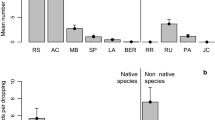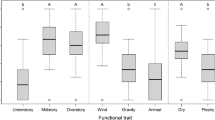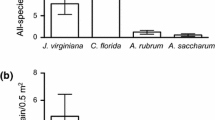Abstract
The seed dispersal patterns of bird-dispersed trees often show substantial seasonal and annual variation due to temporal changes in frugivorous bird and bird-dispersed fruit distributions. Elucidating such variation and how it affects plant regeneration is important for understanding the evolution and seed dispersal maintenance strategies of these plants. In this study, we investigated the seed dispersal quantity and distance of a bird-dispersed plant, Swida controversa, for 2 years and detected large seasonal variations in dispersal pattern. Early in the fruiting season, short seed dispersal distance and large amounts of fruit consumption by birds (seed dispersal quantity) were observed. In contrast, late in the fruiting season, a long seed dispersal distance and small seed dispersal quantity were observed. This relationship between seed dispersal distance and quantity may help to maintain constant seed dispersal effectiveness during the long S. controversa fruiting season. Annual variation was also detected for both seed dispersal quantity and distance. More effective seed dispersal was achieved in the masting year, because both seed dispersal quantity and distance were greater than that in the non-masting year. These seed dispersal dynamics may contribute to the evolution and maintenance of S. controversa masting behavior. Thus, we identified substantial temporal variation on both seasonal and annual scales in the seed dispersal pattern of a bird-dispersed plant. The temporal variation in seed dispersal pattern revealed in this study probably plays a substantial role in the life history and population dynamics of S. controversa.





Similar content being viewed by others
References
Burns K (2005) Is there limiting similarity in the phenology of fleshy fruits? J Veg Sci 16:617–624. doi:10.1111/j.1654-1103.2005.tb02404.x
Carlo T, Morales J (2008) Inequalities in fruit-removal and seed dispersal: consequences of bird behaviour, neighbourhood density and landscape aggregation. J Ecol 96:609–618. doi:10.1111/j.1365-2745.2008.01379.x
Cheung WY, Hubert N, Landry BS (1993) A simple and rapid DNA microextraction method for plant, animal, and insect suitable for RAPD and other PCR analyses. PCR Methods Appl 3:69–70. doi:10.1101/gr.3.1.69
Corlett RT (1998) Frugivory and seed dispersal by vertebrates in the Oriental (Indomalayan) Region. Biol Rev 73:413–448. doi:10.1111/j.1469-185X.1998.tb00178.x
Corlett RT (2009) Seed dispersal distances and plant migration potential in tropical East Asia. Biotropica 41:592–598. doi:10.1111/j.1744-7429.2009.00503.x
Cramer JM, Mesquita RCG, Williamson GB (2007) Forest fragmentation differentially affects seed dispersal of large and small-seeded tropical trees. Biol Conserv 137:415–423
Crawley MJ (2005) Statistics An introduction using R. WIley, West Sussex
Dennis AJ, Schupp EW, Green RJ, Westott DA (2007) Seed dispersal: theory and its application in a changing world. CAB International, Wallingford
Fleming TH, Kress WJ (2011) A brief history of fruits and frugivores. Acta Oecol 37:521–530. doi:10.1016/j.actao.2011.01.016
Fukui A (1995) The role of the brown-eared bulbul Hypsypetes amaurotis as a seed dispersal agent. Res Popul Ecol 37:211–218. doi:10.1007/bf02515822
Godoy J, Jordano P (2001) Seed dispersal by animals: exact identification of source trees with endocarp DNA microsatellites. Mol Ecol 10:2275–2283. doi:10.1046/j.0962-1083.2001.01342.x
Hamilton MB (1999) Tropical tree gene flow and seed dispersal. Nature 401:129–130. doi:10.1038/43597
Hanya G (2005) Comparisons of dispersal success between the species fruiting prior to and those at the peak of migrant frugivore abundance. Plant Ecol 181:167–177. doi:10.1007/s11258-005-5914-4
Herrera CM (1984) A study of avian frugivores, bird-dispersed plants, and their interaction in Mediterranean scrublands. Ecol Monogr 54:2–23. doi:10.2307/1942454
Herrera C (1995) Plant-vertebrate seed dispersal systems in the mediterranean: ecological, evolutionary, and historical determinants. Annu Rev Ecol Syst 26:705–727. doi:10.1146/annurev.es.26.110195.003421
Herrera CM (1998) Long-term dynamics of Mediterranean frugivorous birds and fleshy fruits: a 12-year study. Ecol Monogr 68:511–538. doi:10.1890/0012-9615(1998)068[0511:ltdomf]2.0.co;2
Herrera CM (2002) Seed dipersal by vertebrates plant–animal interactions: an evolutionary approach. Blackwell Publishing, Oxford, pp 185–208
Herrera CM, Jordano P, Guitián J, Traveset A (1998) Annual variability in seed production by woody plants and the masting concept: reassessment of principles and relationship to pollination and seed dispersal. Am Nat 152:576–594. doi:10.1086/286191
Herrera J, Morales J, Garcia D (2011) Differential effects of fruit availability and habitat cover for frugivore-mediated seed dispersal in a heterogeneous landscape. J Ecol 99:1100–1107. doi:10.1111/j.1365-2745.2011.01861.x
Higuchi H, Morioka H, Yamagishi S (1997) The encyclogedia of animals in Japan vol 4: bird 2. Heibonsya, Tokyo
HilleRisLambers J, Clark J, Beckage B (2002) Density-dependent mortality and the latitudinal gradient in species diversity. Nature 417:732–735. doi:10.1038/nature00809
Jordano P, Garcia C, Godoy J, Garcia-Castano J (2007) Differential contribution of frugivores to complex seed dispersal patterns. Proc Natl Acad Sci USA 104:3278–3282. doi:10.1073/pnas.0606793104
Kalinowski S, Taper M, Marshall T (2007) Revising how the computer program CERVUS accommodates genotyping error increases success in paternity assignment. Mol Ecol 16:1099–1106. doi:10.1111/j.1365-294X.2007.03089.x
Kelly D (1994) The evolutionary ecology of mast seeding. Trends Ecol Evol 9:465–470. doi:10.1016/0169-5347(94)90310-7
Kitamura S (2011) Frugivory and seed dispersal by hornbills (Bucerotidae) in tropical forests. Acta Oecol 37:531–541. doi:10.1016/j.actao.2011.01.015
Koike S, Masaki T (2008) Frugivory of carnivora in central and southern parts of Japan analyzed by literature search. J Jpn For Res 90:26–35. doi:10.4005/jjfs.90.26 (in Japanese with English summary)
Koike S, Masaki T, Nemoto Y, Kozakai C, Yamazaki K, Kasai S, Nakajima A, Kaji K (2011) Estimate of the seed shadow created by the Asiatic black bear Ursus thibetanus and its characteristics as a seed disperser in Japanese cool-temperate forest. Oikos 120:280–290. doi:10.1111/j.1600-0706.2010.18626.x
Kominami Y, Sato T, Takeshita K, Manabe T, Endo A, Noma N (2003) Classification of bird-dispersed plants by fruiting phenology, fruit size, and growth form in a primary lucidophyllous forest: an analysis, with implications for the conservation of fruit-bird interactions. Ornithol Sci 2:3–23. doi:10.2326/osj.2.3
Kwit C, Levey DJ, Greenberg CH, Pearson SF, McCarty JP, Sargent S, Mumme RL, Stouffer PC (2004) Fruit abundance and local distribution of wintering Hermit Thrushes (Catharus guttatus) and Yellow-rumped Warblers (Dendroica coronata) in South Carolina. Auk 121:46–57. doi:10.1642/0004-8038(2004)121[0046:FAALDO]2.0.CO;2
Levey DJ, Silva WR, Galetti M (2002) Seed dispersal and frugivory: ecology, evolution, and conservation. CAB International, Wallingford
Levin SA, Muller-Landau HC, Nathan R, Chave J (2003) The ecology and evolution of seed dispersal: a theoretical perspective. Annu Rev Ecol Evol Syst 34:575–604. doi:10.1146/annurev.ecolsys.34.011802.132428
Levine JM, Murrell DJ (2003) The community-level consequences of seed dispersal patterns. Annu Rev Ecol Evol Syst 34:549–574. doi:10.1146/annurev.ecolsys.34.011802.132400
Martínez I, González-Taboada F (2009) Seed dispersal patterns in a temperate forest during a mast event: performance of alternative dispersal kernels. Oecologia 159:389–400. doi:10.1007/s00442-008-1218-4
Martinez I, Garcia D, Ramon Obeso J (2008) Differential seed dispersal patterns generated by a common assemblage of vertebrate frugivores in three fleshy-fruited trees. Ecoscience 15:189–199. doi:10.2980/15-2-3096
Masaki T, Kodani J (2009) Swida controversa Silvics of Japan. Japane Forestry Investigation Committee, Tokyo, pp 611–633
Masaki T, Nakashizuka T (2002) Seedling demography of Swida controversa: effect of light and distance to conspecifics. Ecology 83:3497–3507. doi:10.1890/0012-9658(2002)083[3497:SDOSCE]2.0.CO;2
Masaki T, Suzuki W, Niiyama K, Iida S, Tanaka H, Nakashizuka T (1992) Community structure of a species-rich temperate forest, Ogawa Forest Reserve, central Japan. Vegetatio 98:97–111. doi:10.1007/BF00045549
Masaki T, Kominami Y, Nakashizuka T (1994) Spatial and seasonal patterns of seed dissemination of Cornus controversa in a temperate forest. Ecology 75:1903–1910. doi:10.2307/1941595
Masaki T, Takahashi K, Sawa A, Kado T, Naoe S, Koike S, Shibata M (2012) Fleshy fruit characteristics in a temperate deciduous forest of Japan: how unique are they? J Plant Res 125:103–114. doi:10.1007/s10265-011-0423-0
McConkey KR, Brockelman WY (2011) Nonredundancy in the dispersal network of a generalist tropical forest tree. Ecology 92:1492–1502. doi:10.1890/10-1255.1
Milligan BG (1992) Plant DNA isolation Molecular genetic analysis of populations: a practical approach. IRL Press, Oxford, pp 59–88
Mizoguchi Y, Morishita T, Ohtani Y (2002) Climate in Ogawa Forest Reserve diversity and interaction in a temperate forest community: Ogawa Forest Reserve of Japan. Springer, Tokyo, pp 11–18
Morales J, Carlo TS (2006) The effects of plant distribution and frugivore density on the scale and shape of dispersal kernels. Ecology 87:1489–1496. doi:10.1890/0012-9658(2006)87[1489:TEOPDA]2.0.CO;2
Nakashizuka T, Iida S, Tanaka H, Shibata M, Abe S, Masaki T, Niiyama K (1992) Community dynamics of Ogawa Forest Reserve, a species rich deciduous forest, central Japan. Vegetatio 98:105–112. doi:10.1007/BF00047696
Naoe S, Sakai S, Sawa A, Masaki T (2011) Seasonal difference in the effects of fragmentation on seed dispersal by birds in Japanese temperate forests. Ecol Res 26:301–309. doi:10.1007/s11284-010-0783-2
Noma N, Yumoto T (1997) Fruiting phenology of animal-dispersed plants in response to winter migration of frugivores in a warm temperate forest on Yakushima Island, Japan. Ecol Res 12:119–129. doi:10.1007/BF02523777
Noshiro S (1999) Cornaceae Flora of Japan. Kodansha, Tokyo, pp 254–258
Packer A, Clay K (2000) Soil pathogens and spatial patterns of seedling mortality in a temperate tree. Nature 404:278–281. doi:10.1038/35005072
R Development Core Team (2009) R: a language and environment for statistical computing. R Foundation for Statistical Computing, Vienna
Sakai S, Momose K, Yumoto T, Nagamitsu T, Nagamasu H, Hamid AA, Nakashizuka T (1999) Plant reproductive phenology over four years including an episode of general flowering in a lowland dipterocarp forest, Sarawak, Malaysia. Am J Bot 86:1414–1436
Schupp E (1993) Quantity, quality and the effectiveness of seed dispersal by animals. Vegetatio 107–108:15–29. doi:10.1007/BF00052209
Schupp E, Jordano P, Gomez J (2010) Seed dispersal effectiveness revisited: a conceptual review. New Phytol 188:333–353. doi:10.1111/j.1469-8137.2010.03402.x
Sekercioglu CH (2006) Increasing awareness of avian ecological function. Trends in Ecol and Evol 21:464–471. doi:10.1016/j.tree.2006.05.007
Shibata M, Tanaka H, Iida S, Abe S, Masaki T, Niiyama K, Nakashizuka T (2002) Synchronized annual seed production by 16 principal tree species in a temperate deciduous forest, Japan. Ecology 83:1727–1742. doi:10.1890/0012-9658(2002)083[1727:SASPBP]2.0.CO;2
Spiegel O, Nathan R (2007) Incorporating dispersal distance into the disperser effectiveness framework: frugivorous birds provide complementary dispersal to plants in a patchy environment. Ecol Lett 10:718–728. doi:10.1111/j.1461-0248.2007.01062.x
Takanose Y, Kamitani T (2003) Fruiting of fleshy-fruited plants and abundance of frugivorous birds: phenological correspondence in a temperate forest in central Japan. Ornithol Sci 2:25–32. doi:10.2326/osj.2.25
Tanaka H, Nakashizuka T (2002) Ground design of the research site Diversity and Interaction in a Temperate Forest Community: Ogawa Forest Reserve of Japan. Springer, Tokyo, pp 43–49
Thompson J, Willson M (1979) Evolution of temperate fruit-bird interactions—phenological strategies. Evolution 33:973–982
Tojo H (2009) Breeding bird community of the Ogawa Forest Reserve, an old-growth deciduous forest in central Japan. Ornithol Sci 8:105–115. doi:10.2326/osj.8.105
Weir J, Corlett RT (2007) How far do birds disperse seeds in the degraded tropical landscape of Hong Kong, China? Landsc Ecol 22:131–140. doi:10.1007/s10980-006-9002-5
Wenny DG, Levey DJ (1998) Directed seed dispersal by bellbirds in a tropical cloud forest. Proc Natl Acad Sci USA 95:6204. doi:10.1073/pnas.95.11.6204
Westcott DA, Graham DL (2000) Patterns of movement and seed dispersal of a tropical frugivore. Oecologia 122:249–257. doi:10.1007/PL00008853
Wheelwright NT (1986) The diet of American Robins: an analysis of US Biological Survey records. Auk 103:710–725
Wood SN (2011) Fast stable restricted maximum likelihood and marginal likelihood estimation of semiparametric generalized linear models. J R Stat Soc (B) 73:3–36. doi:10.1111/j.1467-9868.2010.00749.x
Yamazaki M, Iwamoto S, Seiwa K (2009) Distance- and density-dependent seedling mortality caused by several diseases in eight tree species co-occurring in a temperate forest. Plant Ecol 201:181–196. doi:10.1007/s11258-008-9531-x
Yamazaki Y, Kaneko S, Naoe S, Masaki T, Isagi Y (2010) Isolation and characterization of 11 microsatellite loci in Swida controversa (Cornaceae). Conserv Genet Resour 2:145–147. doi:10.1007/s12686-010-9276-4
Yasuda M, Okumura M, Yamazaki K (2010) Mammal records in the Ogawa Forest Reserve and the surrounding area, Kitaibaraki, Ibaraki Prefecture, Japan. Bull Ibaraki Nat Mus 13:99–104
Yoshikawa T, Isagi Y, Kikuzawa K (2009) Relationships between bird-dispersed plants and avian fruit consumers with different feeding strategies in Japan. Ecol Res 24:1301–1311. doi:10.1007/s11284-009-0612-7
Zuur AF, Ieno EN, Walker MJ, Saveliev AA, Smith GM (2009) Mixed effects models and extensions in ecology with R. Springer, New York
Acknowledgments
We thank Dr. S. Abe, A. Fujitsu, S. Harasawa, H. Yamagata, and many others for field assistance; Dr. S. Kaneko for instructing us in the technique used for the genetic experiments; and Dr. M. Yamasaki and Dr. M. Terakawa for useful advice. This work was supported by the Japan Society for the Promotion of Science (JSPS) Research Fellowship for Young Scientists to Yoshihiro Yamazaki and by a Grant-in-Aid for Scientific Research (Grant 19201048) from the JSPS to Takashi Masaki. Part of this study was financially supported by the Pollution Control Research Fun from the Ministry of the Environment, Japan.
Author information
Authors and Affiliations
Corresponding author
Electronic supplementary material
Below is the link to the electronic supplementary material.
About this article
Cite this article
Yamazaki, Y., Naoe, S., Masaki, T. et al. Temporal variations in seed dispersal patterns of a bird-dispersed tree, Swida controversa (Cornaceae), in a temperate forest. Ecol Res 31, 165–176 (2016). https://doi.org/10.1007/s11284-015-1324-9
Received:
Accepted:
Published:
Issue Date:
DOI: https://doi.org/10.1007/s11284-015-1324-9




